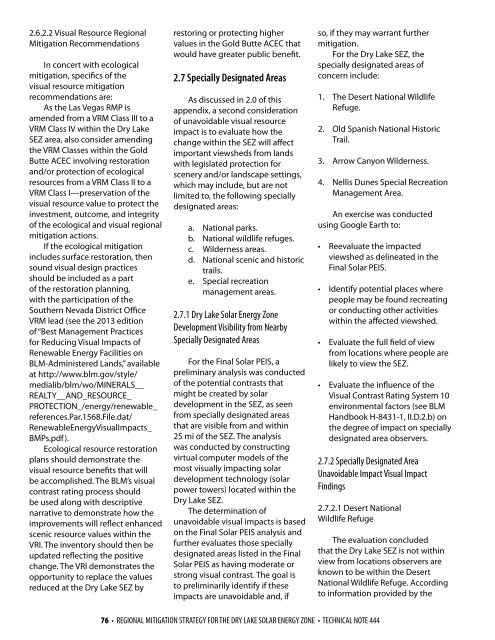xs7hy9e06w?redirect_to=http://www.blm.gov/pgdata/etc/medialib/blm/wo/blm_library/tech_notes.Par.29872.File.dat/TN_444
xs7hy9e06w?redirect_to=http://www.blm.gov/pgdata/etc/medialib/blm/wo/blm_library/tech_notes.Par.29872.File.dat/TN_444
xs7hy9e06w?redirect_to=http://www.blm.gov/pgdata/etc/medialib/blm/wo/blm_library/tech_notes.Par.29872.File.dat/TN_444
Create successful ePaper yourself
Turn your PDF publications into a flip-book with our unique Google optimized e-Paper software.
2.6.2.2 Visual Resource Regional<br />
Mitigation Recommen<strong>dat</strong>ions<br />
In concert with ecological<br />
mitigation, specifics of the<br />
visual resource mitigation<br />
recommen<strong>dat</strong>ions are:<br />
As the Las Vegas RMP is<br />
amended from a VRM Class III to a<br />
VRM Class IV within the Dry Lake<br />
SEZ area, also consider amending<br />
the VRM Classes within the Gold<br />
Butte ACEC involving restoration<br />
and/or protection of ecological<br />
resources from a VRM Class II to a<br />
VRM Class I—preservation of the<br />
visual resource value to protect the<br />
investment, outcome, and integrity<br />
of the ecological and visual regional<br />
mitigation actions.<br />
If the ecological mitigation<br />
includes surface restoration, then<br />
sound visual design practices<br />
should be included as a part<br />
of the restoration planning,<br />
with the participation of the<br />
Southern Nevada District Office<br />
VRM lead (see the 2013 edition<br />
of “Best Management Practices<br />
for Reducing Visual Impacts of<br />
Renewable Energy Facilities on<br />
BLM-Administered Lands,” available<br />
at http://<strong>www</strong>.<strong>blm</strong>.<strong>gov</strong>/style/<br />
<strong>medialib</strong>/<strong>blm</strong>/<strong>wo</strong>/MINERALS__<br />
REALTY__AND_RESOURCE_<br />
PROTECTION_/energy/renewable_<br />
references.Par.1568.File.<strong>dat</strong>/<br />
RenewableEnergyVisualImpacts_<br />
BMPs.pdf).<br />
Ecological resource restoration<br />
plans should demonstrate the<br />
visual resource benefits that will<br />
be accomplished. The BLM’s visual<br />
contrast rating process should<br />
be used along with descriptive<br />
narrative to demonstrate how the<br />
improvements will reflect enhanced<br />
scenic resource values within the<br />
VRI. The inventory should then be<br />
up<strong>dat</strong>ed reflecting the positive<br />
change. The VRI demonstrates the<br />
opportunity to replace the values<br />
reduced at the Dry Lake SEZ by<br />
restoring or protecting higher<br />
values in the Gold Butte ACEC that<br />
<strong>wo</strong>uld have greater public benefit.<br />
2.7 Specially Designated Areas<br />
As discussed in 2.0 of this<br />
appendix, a second consideration<br />
of unavoidable visual resource<br />
impact is to evaluate how the<br />
change within the SEZ will affect<br />
important viewsheds from lands<br />
with legislated protection for<br />
scenery and/or landscape settings,<br />
which may include, but are not<br />
limited to, the following specially<br />
designated areas:<br />
a. National parks.<br />
b. National wildlife refuges.<br />
c. Wilderness areas.<br />
d. National scenic and historic<br />
trails.<br />
e. Special recreation<br />
management areas.<br />
2.7.1 Dry Lake Solar Energy Zone<br />
Development Visibility from Nearby<br />
Specially Designated Areas<br />
For the Final Solar PEIS, a<br />
preliminary analysis was conducted<br />
of the potential contrasts that<br />
might be created by solar<br />
development in the SEZ, as seen<br />
from specially designated areas<br />
that are visible from and within<br />
25 mi of the SEZ. The analysis<br />
was conducted by constructing<br />
virtual computer models of the<br />
most visually impacting solar<br />
development <strong>tech</strong>nology (solar<br />
power towers) located within the<br />
Dry Lake SEZ.<br />
The determination of<br />
unavoidable visual impacts is based<br />
on the Final Solar PEIS analysis and<br />
further evaluates those specially<br />
designated areas listed in the Final<br />
Solar PEIS as having moderate or<br />
strong visual contrast. The goal is<br />
to preliminarily identify if these<br />
impacts are unavoidable and, if<br />
so, if they may warrant further<br />
mitigation.<br />
For the Dry Lake SEZ, the<br />
specially designated areas of<br />
concern include:<br />
1. The Desert National Wildlife<br />
Refuge.<br />
2. Old Spanish National Historic<br />
Trail.<br />
3. Arrow Canyon Wilderness.<br />
4. Nellis Dunes Special Recreation<br />
Management Area.<br />
An exercise was conducted<br />
using Google Earth to:<br />
• Reevaluate the impacted<br />
viewshed as delineated in the<br />
Final Solar PEIS.<br />
• Identify potential places where<br />
people may be found recreating<br />
or conducting other activities<br />
within the affected viewshed.<br />
• Evaluate the full field of view<br />
from locations where people are<br />
likely to view the SEZ.<br />
• Evaluate the influence of the<br />
Visual Contrast Rating System 10<br />
environmental factors (see BLM<br />
Handbook H-8431-1, II.D.2.b) on<br />
the degree of impact on specially<br />
designated area observers.<br />
2.7.2 Specially Designated Area<br />
Unavoidable Impact Visual Impact<br />
Findings<br />
2.7.2.1 Desert National<br />
Wildlife Refuge<br />
The evaluation concluded<br />
that the Dry Lake SEZ is not within<br />
view from locations observers are<br />
known to be within the Desert<br />
National Wildlife Refuge. According<br />
to information provided by the<br />
76 • REGIONAL MITIGATION STRATEGY FOR THE DRY LAKE SOLAR ENERGY ZONE • TECHNICAL NOTE <strong>444</strong>


